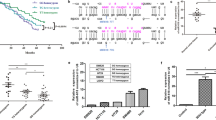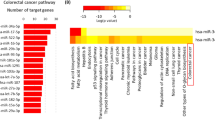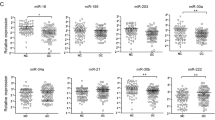Abstract
MicroRNAs (miRNAs) are noncoding RNAs that function as post-transcriptional regulators of tumor oncogenes and suppressors. Single-nucleotide polymorphisms (SNPs) in miRNA genes are a novel class of genetic variations in the human genome that are currently being identified and investigated in human cancers. In this study, we aimed to investigate whether SNPs in the miR-27a gene affect miR-27a expression and alter susceptibility to gastric cancer. Therefore, we conducted a case–control population study and the allele and genotype frequencies for polymorphism rs11671784 in miR-27a gene were examined in the study population. As a result, we found that the G/A polymorphism in the miR-27a gene exhibited a significant effect on gastric cancer risk. Compared with GG homozygotes, subjects who were GA heterozygotes or AA homozygotes exhibited a decreased risk of gastric cancer. The G/A polymorphism impaired the processing of pre-miR-27a to mature miR-27a, resulting in significantly reduced expression of mature miR-27a and an increased level of its target HOXA10. Furthermore, we confirmed these findings in in vitro studies by overexpressing pre-miR-27a carrying G or A allele. It provided further evidence demonstrating that allelic difference of rs11671784 is linked to gastric tumorigenesis. In summary, our results indicate that the G/A polymorphism in miR-27a gene (rs11671784) decreases miR-27a expression, reduces gastric cancer risk and plays a role in gastric tumorigenesis. This is the first study to address the role and function of miR-27a polymorphism rs11671784 in gastric cancer. These results could be useful to assess individual susceptibility of gastric cancer and will improve our understanding of the potential contribution of miRNA SNPs to cancer pathogenesis.
This is a preview of subscription content, access via your institution
Access options
Subscribe to this journal
Receive 50 print issues and online access
$259.00 per year
only $5.18 per issue
Buy this article
- Purchase on Springer Link
- Instant access to full article PDF
Prices may be subject to local taxes which are calculated during checkout




Similar content being viewed by others
References
Kelley JR, Duggan JM . Gastric cancer epidemiology and risk factors. J Clin Epidemiol 2003; 56: 1–9.
Bornschein J, Rokkas T, Selgrad M, Malfertheiner P . Gastric cancer: clinical aspects, epidemiology and molecular background. Helicobacter 2011; 16 (Suppl 1): 45–52.
González CA, Agudo A . Carcinogenesis, prevention and early detection of gastric cancer: where we are and where we should go. Int J Cancer 2012; 130: 745–753.
Yang L, Parkin DM, Ferlay J, Li L, Chen Y . Estimates of cancer incidence in China for 2000 and projections for 2005. Cancer Epidemiol Biomarkers Prev 2005; 14: 243–250.
Leung WK, Wu MS, Kakugawa Y, Kim JJ, Yeoh KG, Goh KL et al. Screening for gastric cancer in Asia: current evidence and practice. Lancet Oncol 2008; 9: 279–287.
Esquela-Kerscher A, Slack FJ . Oncomirs - microRNAs with a role in cancer. Nat Rev Cancer 2006; 6: 259–269.
Carthew RW, Sontheimer EJ . Origins and mechanisms of miRNAs and siRNAs. Cell 2009; 136: 642–655.
Iorio MV, Croce CM . MicroRNAs in cancer: small molecules with a huge impact. J Clin Oncol 2009; 27: 5848–5856.
Lee Y, Ahn C, Han J, Choi H, Kim J, Yim J et al. The nuclear RNase III Drosha initiates microRNA processing. Nature 2003; 425: 415–419.
Han J, Lee Y, Yeom KH, Kim YK, Jin H, Kim VN . The Drosha-DGCR8 complex in primary microRNA processing. Genes Dev 2004; 18: 3016–3027.
Han J, Lee Y, Yeom KH, Nam JW, Heo I, Rhee JK et al. Molecular basis for the recognition of primary microRNAs by the Drosha-DGCR8 complex. Cell 2006; 125: 887–901.
Bushati N, Cohen SM . microRNA functions. Annu Rev Cell Dev Biol 2007; 23: 175–205.
Baek D, Villen J, Shin C, Camargo FD, Gygi SP, Bartel DP . The impact of microRNAs on protein output. Nature 2008; 455: 64–71.
Calin GA, Sevignani C, Dumitru CD, Hyslop T, Noch E, Yendamuri S et al. Human microRNA genes are frequently located at fragile sites and genomic regions involved in cancers. Proc Natl Acad Sci USA 2004; 101: 2999–3004.
Lu J, Getz G, Miska EA, Alvarez-Saavedra E, Lamb J, Peck D et al. MicroRNA expression profiles classify human cancers. Nature 2005; 435: 834–838.
Calin GA, Croce CM . MicroRNA signatures in human cancers. Nat Rev Cancer 2006; 6: 857–866.
Calin GA, Croce CM . MicroRNA-cancer connection: the beginning of a new tale. Cancer Res 2006; 66: 7390–7394.
Bandres E, Bitarte N, Arias F, Agorreta J, Fortes P, Agirre X et al. MicroRNA-451 regulates macrophage migration inhibitory factor production and proliferation of gastrointestinal cancer cells. Clin Cancer Res 2009; 15: 2281–2290.
Kogo R, Mimori K, Tanaka F, Komune S, Mori M . Clinical significance of miR-146a in gastric cancer cases. Clin Cancer Res 2011; 17: 4277–4284.
Yang Q, Jie Z, Cao H, Greenlee AR, Yang C, Zou F et al. Low-level expression of let-7a in gastric cancer and its involvement in tumorigenesis by targeting RAB40C. Carcinogenesis 2011; 32: 713–722.
Chintharlapalli S, Papineni S, Abdelrahim M, Abudayyeh A, Jutooru I, Chadalapaka G et al. Oncogenic microRNA-27a is a target for anticancer agent methyl 2-cyano-3,11-dioxo-18beta-olean-1,12-dien-30-oate in colon cancer cells. Int J Cancer 2009; 125: 1965–1974.
Liu T, Tang H, Lang Y, Liu M, Li X . MicroRNA-27a functions as an oncogene in gastric adenocarcinoma by targeting prohibitin. Cancer Lett 2009; 273: 233–242.
Lerner M, Lundgren J, Akhoondi S, Jahn A, Ng HF, Moqadam FA et al. MiRNA-27a controls FBW7/hCDC4-dependent cyclin E degradation and cell cycle progression. Cell Cycle 2011; 10: 2172–2183.
Wang Q, Li DC, Li ZF, Liu CX, Xiao YM, Zhang B et al. Upregulation of miR-27a contributes to the malignant transformation of human bronchial epithelial cells induced by SV40 small T antigen. Oncogene 2011; 30: 3875–3886.
Katada T, Ishiguro H, Kuwabara Y, Kimura M, Mitui A, Mori Y et al. microRNA expression profile in undifferentiated gastric cancer. Int J Oncol 2009; 34: 537–542.
Kumar MS, Lu J, Mercer KL, Golub TR, Jacks T . Impaired microRNA processing enhances cellular transformation and tumorigenesis. Nat Genet 2007; 39: 673–677.
Saunders MA, Liang H, Li WH . Human polymorphism at microRNAs and microRNA target sites. Proc Natl Acad Sci USA 2007; 104: 3300–3305.
Sun G, Yan J, Noltner K, Feng J, Li H, Sarkis DA et al. SNPs in human miRNA genes affect biogenesis and function. RNA 2009; 15: 1640–1651.
Ryan BM, Robles AI, Harris CC . Genetic variation in microRNA networks: the implications for cancer research. Nat Rev Cancer 2010; 10: 389–402.
Lewis BP, Shih IH, Jones-Rhoades MW, Bartel DP, Burge CB . Prediction of mammalian microRNA targets. Cell 2003; 115: 787–798.
Sun Q, Gu H, Zeng Y, Xia Y, Wang Y, Jing Y et al. Hsa-mir-27a genetic variant contributes to gastric cancer susceptibility through affecting miR-27a and target gene expression. Cancer Sci 2010; 101: 2241–2247.
Zhou Y, Du WD, Chen G, Ruan J, Xu S, Zhou FS et al. Association analysis of genetic variants in microRNA networks and gastric cancer risk in a Chinese Han population. J Cancer Res Clin Oncol 2012; 138: 939–945.
Catucci I, Verderio P, Pizzamiglio S, Bernard L, Dall'olio V, Sardella D et al. The SNP rs895819 in miR-27a is not associated with familial breast cancer risk in Italians. J Cancer Res Clin Oncol 2012; 133: 805–807.
Zhang M, Jin M, Yu Y, Zhang S, Wu Y, Liu H et al. Associations of miRNA polymorphisms and female physiological characteristics with breast cancer risk in Chinese population. Eur J Cancer Care 2012; 21: 274–280.
Duan R, Pak C, Jin P . Single nucleotide polymorphism associated with mature miR-125a alters the processing of pri-miRNA. Hum Mol Genet 2007; 16: 1124–1131.
Jazdzewski K, Murray EL, Franssila K, Jarzab B, Schoenberg DR, de la Chapelle A . Common SNP in pre-miR-146a decreases mature miR expression and predisposes to papillary thyroid carcinoma. Proc Natl Acad Sci USA 2008; 105: 7269–7274.
Hu Y, Liu CM, Qi L, He TZ, Shi-Guo L, Hao CJ et al. Two common SNPs in pri-miR-125a alter the mature miRNA expression and associate with recurrent pregnancy loss in a Han-Chinese population. RNA Biol 2011; 8: 258–264.
Labbaye C, Spinello I, Quaranta MT, Pelosi E, Pasquini L, Petrucci E et al. A three-step pathway comprising PLZF/miR-146a/CXCR4 controls megakaryopoiesis. Nat Cell Biol 2008; 10: 788–801.
Jazdzewski K, Liyanarachchi S, Swierniak M, Pachucki J, Ringel MD, Jarzab B et al. A Polymorphic mature microRNAs from passenger strand of pre-miR-146a contribute to thyroid cancer. Proc Natl Acad Sci USA 2009; 106: 1502–1505.
Nunes FD, de Almeida FC, Tucci R, de Sousa SC . Homeobox genes: a molecular link between development and cancer. Pesqui Odontol Bras 2003; 17: 94–98.
Shah N, Sukumar S . The Hox genes and their roles in oncogenesis. Nat Rev Cancer 2010; 10: 361–371.
Plowright L, Harrington KJ, Pandha HS, Morgan R . HOX transcription factors are potential therapeutic targets in non-small-cell lung cancer (targeting HOX genes in lung cancer). Br J Cancer 2009; 100: 470–475.
Cantile M, Franco R, Schiavo G, Procino A, Cindolo L, Botti G et al. The HOX genes network in uro-genital cancers: mechanisms and potential therapeutic implications. Curr Med Chem 2011; 18: 4872–4884.
Cillo C, Schiavo G, Cantile M, Bihl MP, Sorrentino P, Carafa V et al. The HOX gene network in hepatocellular carcinoma. Int J Cancer 2011; 29: 2577–2587.
Acknowledgements
We thank Xin Zhou and Wei Li (Department of General Surgery, First Affiliated Hospital of Nanchang University) for collecting the clinicopathologic information utilized in this study. We thank Chengjie Liang (Laboratory Animal Center, Guangzhou Medical University) for assistance with the nude mice assays. This work was supported by the National Natural Science Foundation of China (30771780, 30972443 to YJ and 81102099 to QY), the Natural Science Foundation of Guangdong Province (9251018201000004 to YJ), the University Talent Program of Guangdong (2010-79 to YJ) and the University Talent Program of Guangzhou (10A003D to YJ).
Author information
Authors and Affiliations
Corresponding author
Ethics declarations
Competing interests
The authors declare no conflict of interest.
Additional information
Supplementary Information accompanies the paper on the Oncogene website
Supplementary information
Rights and permissions
About this article
Cite this article
Yang, Q., Jie, Z., Ye, S. et al. Genetic variations in miR-27a gene decrease mature miR-27a level and reduce gastric cancer susceptibility. Oncogene 33, 193–202 (2014). https://doi.org/10.1038/onc.2012.569
Received:
Revised:
Accepted:
Published:
Issue Date:
DOI: https://doi.org/10.1038/onc.2012.569
Keywords
This article is cited by
-
Integrated multi-dimensional analysis highlights DHCR7 mutations involving in cholesterol biosynthesis and contributing therapy of gastric cancer
Journal of Experimental & Clinical Cancer Research (2023)
-
A systematic review of microRNAs as potential biomarkers for diagnosis and prognosis of gastric cancer
Immunogenetics (2021)
-
MiR-27a rs895819 is involved in increased atrophic gastritis risk, improved gastric cancer prognosis and negative interaction with Helicobacter pylori
Scientific Reports (2017)
-
Dissection of allelic interactions among Pto-miR257 and its targets and their effects on growth and wood properties in Populus
Heredity (2016)
-
RETRACTED ARTICLE: MicroRNA-216b is Down-Regulated in Human Gastric Adenocarcinoma and Inhibits Proliferation and Cell Cycle Progression by Targeting Oncogene HDAC8
Targeted Oncology (2016)



